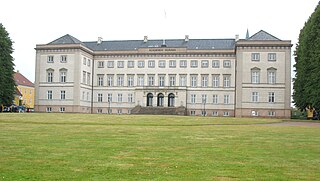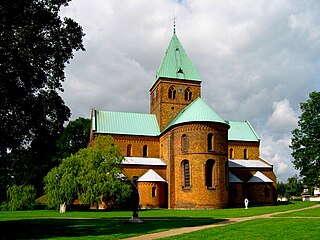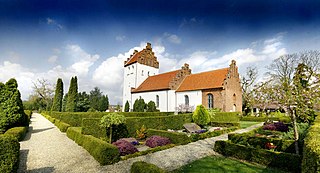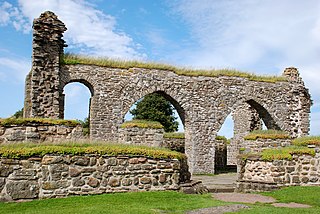Related Research Articles

Absalon was a Danish statesman and prelate of the Catholic Church who served as the bishop of Roskilde from 1158 to 1192 and archbishop of Lund from 1178 until his death. He was the foremost politician and church father of Denmark in the second half of the 12th century, and was the closest advisor of King Valdemar I of Denmark. He was a key figure in the Danish policies of territorial expansion in the Baltic Sea, Europeanization in close relationship with the Holy See, and reform in the relation between the Church and the public. He combined the ideals of Gregorian Reform with loyal support of a strong monarchical power.

Sorø is a town in Sorø municipality on the island of Zealand in east Denmark with a population of 8,400 (2024). It lies on the northeastern shore of Sorø Lake. The municipal council and the regional council are located in Sorø.

Julita Abbey was a monastery of the Cistercian monks in the parish of Julita in Oppunda Hundred, Södermanland, Sweden.
Svantepolk Knutsson was a Swedish knight and councilor. He became a wealthy feudal lord in Östergötland.

Antvorskov Monastery was the principal Scandinavian monastery of the Catholic Order of Saint John of Jerusalem, located about one kilometer south of the town of Slagelse on Zealand, Denmark.
Martha of Denmark was Queen of Sweden by marriage to King Birger. She was given the name Margaret at birth, but in Sweden was called Martha, and has been known to history by that name. She was regarded as a politically influential queen and an important figure in the Håtuna games and the Nyköping Banquet.

Sophia of Denmark was Queen of Sweden as the consort of King Valdemar.

Løgum Abbey was a Cistercian monastery in the present town of Løgumkloster in North Schleswig, Denmark. In 1548, the monastery was closed down. The site is now occupied by Løgumkloster Church.

Sorø Abbey was the preeminent and wealthiest monastic house in all of Denmark during the Middle Ages. It was located in the town of Sorø in central Zealand.

St. Catherine's Priory, Roskilde was a Danish priory of Dominican friars located in Roskilde. It was established in 1231 and dissolved during the Reformation. In 1699, the private house which replaced the Priory, became the Lutheran Roskilde Adelige Jomfrukloster, a women's collegiate foundation.

Roskilde Abbey or Our Lady's Abbey, Roskilde, was a nunnery dedicated to Saint Mary the Virgin. The abbey was located at Roskilde on the Danish island of Zealand. It was founded in the early 12th century for Benedictine nuns, but in 1177 became part of the Cistercian reform movement. The abbey was suppressed in 1536 during the Protestant Reformation in Denmark. It is now the site the Old Church of Our Lady, Roskilde .
St. Agnes' Priory was a Danish convent for women of the Dominican Order. It was situated in Roskilde and was in operation from 1264 until the Danish Reformation. .

Ringsted Abbey was one of the earliest and most influential Benedictine houses in Denmark, active from the late 11th-century until the Danish Reformation. It was located at Ringsted on the Danish island of Zealand.
Saint Canute's Abbey, Odense was a Benedictine monastery built to support the pilgrimage centre for the relics of the royal Danish martyr Saint Canute, and was the successor to the priory of St. Mary and St. Alban, Denmark's earliest monastic house. Located in Odense, it was the island of Funen's most important medieval religious institution.

Ås Abbey was a Cistercian monastery situated near the present village of Åskloster about 14 km north of Varberg, in Varberg Municipality. It was located near the mouth of the River Viskan into the Kattegat in Halland, formerly part of Denmark but now in Sweden

Vårfruberga Abbey, previously Fogdö Abbey was a Cistercian monastery of nuns from the 12th century until 1527, situated 1 mile north-west of Strängnäs on the Fogdö peninsula in Lake Mälaren, formerly a parish, in Södermanland, Sweden.

St. Bendt's Church is a church in Ringsted, Denmark, which was originally part of a Benedictine monastery that burnt down in the 18th century. Built in the Romanesque style, it is the oldest brick church in Scandinavia, dating back to about 1170 when it replaced a travertine church from about 1080. It is considered to be one of Denmark's architecturally finest churches. Furthermore, it is of special historical interest as it is the first Royal church in Denmark and it houses the tombs of many of Denmark's earlier monarchs and noblemen.

Skjalm Hvide, was the Earl of Zealand in Denmark in the end of the Viking Age (793–1066) and up to his death. Skjalm's father was Toke Trylle, whose father was Slag, based on Absalon, a medieval account scanned, translated and published by Google.

Gudhem Abbey is the ruin of a nunnery which was in operation from 1152 to 1529. It is located in Gudhem outside Falköping in the Falbygden area in Västergötland, Sweden. It was initially part of the Benedictine and later Cistercian order. It is considered to have been one of the oldest convents in Sweden; after Vreta Abbey (1100) and Alvastra Abbey (1143).

Bergen auf Rügen Abbey was a monastery for Cistercian nuns established on the Baltic Sea island of Rügen. It lasted from the end of the 12th century to the early 16th century as a Roman-Catholic monastery and then, until 1945, as a Protestant aristocratic nunnery.
References
- ↑ "Slangerup Kloster". Roskilde Historie. Retrieved July 1, 2020.
- ↑ "Slangerup Bykommune". Kongeriget Danmark. Retrieved July 1, 2020.
- ↑ "Erik Ejegod". Danmarks Historie. Retrieved July 1, 2020.
- ↑ status indicated by, e.g., Esrum klosters brevbog, Bent Christensen, p. 124, Museum Tusculanum Press, 2002, ISBN 87-7289-754-6, ISBN 978-87-7289-754-7, online at google.books.co.uk
- ↑ "Valdemar den Store (1157-82)". Danmarkshistorien. Retrieved July 1, 2020.
- ↑ "Birger". Svenskt biografiskt lexikon. Retrieved July 1, 2020.
- ↑ "Märta". Svenskt biografiskt lexikon. Retrieved July 1, 2020.
- ↑ "Slangerup kirke Skt. Mikaels historie". Slangerup kirke Skt. Mikaels. Retrieved July 1, 2020.